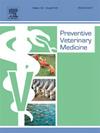Contrasting roles of farm categories in the enzootic circulation of bovine brucellosis through cattle trade in Paraguay
IF 2.4
2区 农林科学
Q1 VETERINARY SCIENCES
引用次数: 0
Abstract
Bovine brucellosis leads to significant economic losses in enzootic regions due to infertility, abortion, weak calves, and reduced milk and meat production. In humans, this zoonotic disease often results in a chronic, debilitating illness. In Paraguay, where cattle farming is an important sector of the economy, bovine brucellosis remains enzootic all over the country. We developed a within- and between-farm stochastic model to assess the potential of the female trade network in sustaining country-wide transmission of bovine brucellosis and to identify the roles of different farm categories in its transmission. A national serosurvey and cattle trade data were used to estimate the intra-farm transmission parameters, and the effective reproduction number R at the country and farm levels. Results showed that replacement heifer trade sustained transmission among farms. Country-level R was 1.06 (95 % HDI: 0.23–2.19), suggesting a dynamic close to the epidemiological equilibrium, which is consistent with the history of bovine brucellosis in this country. Farm category analysis revealed that R ranged from 0.14 to 2.00 with the lowest values observed in small farms and the highest in large farms, indicating that small farms contributed little to brucellosis transmission, medium farms had a neutral impact and large farms played a major role. Disease persistence was mainly driven by within-region transmission, with large farms facilitating spread between regions. These findings highlighted the need for region- and farm-category control strategies to effectively manage bovine brucellosis. The model implemented in this work gave valuable insights into the bovine brucellosis dynamics in Paraguay and could be used to test different control approaches.
通过巴拉圭的牛贸易,农场类别在牛布鲁氏菌病地方性传播中的对比作用
牛布鲁氏菌病由于不育、流产、犊牛虚弱以及奶和肉产量减少,在地方性动物患病地区造成重大经济损失。在人类中,这种人畜共患疾病通常导致慢性衰弱性疾病。在养牛是巴拉圭重要经济部门的巴拉圭,牛布鲁氏菌病仍然是全国各地的地方性疾病。我们开发了一个农场内部和农场之间的随机模型,以评估女性贸易网络在维持全国范围内牛布鲁氏菌病传播方面的潜力,并确定不同农场类别在其传播中的作用。利用全国血清调查和牛交易数据来估计农场内传播参数,以及国家和农场层面的有效繁殖数R。结果表明,替代小母牛贸易在农场间持续传播。国家一级的R为1.06(95 % HDI: 0.23-2.19),表明动态接近流行病学平衡,这与该国牛布鲁氏菌病的历史一致。养殖场分类分析显示,R值在0.14 ~ 2.00之间,其中小型养殖场最低,大型养殖场最高,表明小型养殖场对布鲁氏菌病传播贡献不大,中型养殖场影响不大,大型养殖场起主要作用。疾病持续性主要由区域内传播驱动,大型养殖场促进了区域间传播。这些发现突出表明需要制定区域和农场控制战略来有效管理牛布鲁氏菌病。在这项工作中实施的模型为巴拉圭的牛布鲁氏菌病动态提供了宝贵的见解,并可用于测试不同的控制方法。
本文章由计算机程序翻译,如有差异,请以英文原文为准。
求助全文
约1分钟内获得全文
求助全文
来源期刊

Preventive veterinary medicine
农林科学-兽医学
CiteScore
5.60
自引率
7.70%
发文量
184
审稿时长
3 months
期刊介绍:
Preventive Veterinary Medicine is one of the leading international resources for scientific reports on animal health programs and preventive veterinary medicine. The journal follows the guidelines for standardizing and strengthening the reporting of biomedical research which are available from the CONSORT, MOOSE, PRISMA, REFLECT, STARD, and STROBE statements. The journal focuses on:
Epidemiology of health events relevant to domestic and wild animals;
Economic impacts of epidemic and endemic animal and zoonotic diseases;
Latest methods and approaches in veterinary epidemiology;
Disease and infection control or eradication measures;
The "One Health" concept and the relationships between veterinary medicine, human health, animal-production systems, and the environment;
Development of new techniques in surveillance systems and diagnosis;
Evaluation and control of diseases in animal populations.
 求助内容:
求助内容: 应助结果提醒方式:
应助结果提醒方式:


